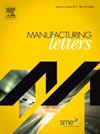用吹粉定向能沉积法制造单晶胞
IF 2
Q3 ENGINEERING, MANUFACTURING
引用次数: 0
摘要
通过增材制造制造的晶格结构显示出改变现有组件以改善基础结构的热机械性能的独特前景。本研究探讨了用吹粉定向能沉积法制备自支撑晶格结构的方法。采用多个倾斜角度制造收敛杆,以促进结构的自支撑,避免机器与零件的碰撞。在倾斜角度为10°时,支撑相对于拟合线的直线度接近均匀,最大偏差为1mm。显微硬度和孔隙度评价结果显示,沿支板方向变化不显著。本文章由计算机程序翻译,如有差异,请以英文原文为准。
Unit cell manufacture by blown powder directed energy deposition
Lattice structures manufactured by additive manufacturing show unique promise to alter existing components to improve the thermo-mechanical properties of the base structure. In the present study, the manufacture of a self-supporting lattice structure by blown powder directed energy deposition was explored. Converging struts were manufactured using multiple lean angles to facilitate the self-supporting structure and to avoid machine-part collisions. The struts showed near uniform straightness relative to a fitted line with a maximum deviation of 1mm at a lean angle of 10°. Micro–hardness and porosity evaluation results showed no significant variation along the struts.
求助全文
通过发布文献求助,成功后即可免费获取论文全文。
去求助
来源期刊

Manufacturing Letters
Engineering-Industrial and Manufacturing Engineering
CiteScore
4.20
自引率
5.10%
发文量
192
审稿时长
60 days
 求助内容:
求助内容: 应助结果提醒方式:
应助结果提醒方式:


